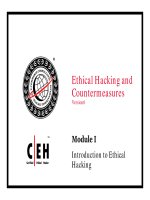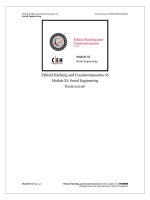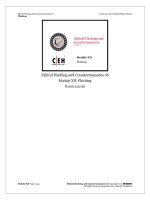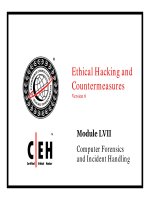Ethical hacking and countermeasures - phần 32 docx
Bạn đang xem bản rút gọn của tài liệu. Xem và tải ngay bản đầy đủ của tài liệu tại đây (640.84 KB, 56 trang )
Ethical
Hacking
Version 5
Exploit Writing Using
Metasploit Fram ework
EC-Council
What is Metasploit Framework?
It is a open-source and freely available exploit
development framework released under GPL
license
The Metasploit Framework is written in the Perl
scripting language and can run on Linux and
Windows (using the Cygwin environment for
Windows)
The framework provides the following
interfaces:
• Msfcli
• Msfweb
• msfconsole
EC-Council
msfconsole
The msfconsole is an interactive command-line
interface provides a command set that allows the user
to manipulate the framework environment, set exploit
options, and deploy the exploit
Commands:
• show exploits
– Lists the available exploits
• info
– Shows the different aspects of the exploit like target platforms,
payloads etc.
• use
– Uses the exploit
• help
– Lists available commands
EC-Council
Screenshot
EC-Council
Show exploits
EC-Council
help
EC-Council
Web Interface
EC-Council
Running an exploit using the console
>use iis40_htr
>show targets
>show options
>set RHOST 10.0.0.5
>show advanced
>show payloads
>set PAYLOAD win32_bind
>exploit
EC-Council
Exploit Development with Metasploit
Writing an exploit requires an in-depth
understanding of the target architecture’s
assembly language, detailed knowledge of the
operating system’s internal structures, and
considerable programming skill
Metasploit greatly simplifies the exploit
development
The first step in writing an exploit is to
determine the specific attack vector against the
target host
EC-Council
msw3prt.dll
Windows 2000 Internet printing ISAPI extension
contains msw3prt.dll which handles user requests
Due to an unchecked buffer in msw3prt.dll, a
maliciously crafted HTTP .printer request containing
approx 420 bytes in the 'Host:' field will allow the
execution of arbitrary code
Typically a web server would stop responding in a
buffer overflow condition; however, once Windows
2000 detects an unresponsive web server it
automatically performs a restart
EC-Council
Example
We will demonstrate how to develop an exploit
for IIS msw3prt.dll vulnerability in Windows
2000 SP0
Our exploit will cause a buffer overflow in a
component called msw3prt.dll, also known as
the .printer ISAPI filter, which gives the
operating system support for the Internet
Printing Protocol
Our exploit will overwrite the instruction
pointer with a location in memory that jumps to
our program's exploit code
EC-Council
What you will need?
You will need the following to create the exploit
• Metasploit framework
• ActivePerl
• Debugger for Windows
• OllyDbg Debugger
• netcat
EC-Council
Determining the Attack Vector
First
• The attack vector of the vulnerability is determined
Second
• The offset of the overflow vulnerability must be calculated
Third
• Find the valid return address
Fourth
• Determine the character and size limitations
Fifth
• Create a nop sled
Sixth
• Select the payload, generate and encode
Exploit!
EC-Council
First - The attack vector of the
vulnerability is determined
Find the offset
$string = "GET /NULL.printer
HTTP/1.0\nHost: ";
$string .= "A" x 500;
$string .= "\n\n";
open(NC, "|nc.exe 127.0.0.1 80");
print NC $string;
close(NC);
EC-Council
Debugger
1. Attach the debugger to the inetinfo.exe process. Ensure that the
process continues execution after being interrupted.
2. Execute the script in the previous slide
3. The attack string should overwrite the return address.
4. The return address is popped into EIP.
5. When the processor attempts to access the invalid address stored
in EIP, the system will throw an access violation.
6. The access violation is caught by the debugger, and the process
halts.
7. When the process halts, the debugger will display process
information including virtual memory, disassembly, the current
stack, and the register states.
EC-Council
code
inetinfo attached
to debugger
Perl code
EC-Council
Inetinfo process attached to debugger
EC-Council
Execute the perl code
EC-Council
EIP is overwritten with “AAAA”
AAAA in
hexadecimal is
41414141
EC-Council
OllyDbg Screen
EC-Council
EIP
In the debugger window shown in the previous
slide, EIP has been overwritten with the
hexadecimal value
0x41414141
This corresponds to the ASCII string AAAA,
which is a piece of Data that was sent to IIS
Because the processor attempts to access the
invalid memory address,
0x41414141, the
process halts in the debugger
EC-Council
Analysis of the code
In line 1, we start to build the attack
string by specifying a GET request
In line 2, we append a string of 500 “A”
characters
In line 3, we add carriage return and
newline characters that terminate the
request
In line 4, a pipe is created between the NC
file handle and the Netcat utility. The
Netcat utility has been instructed to
connect to the target host at 127.0.0.1 on
port 80
In line 5, the $string data is printed to the
NC file handle. The NC file handle then
passes the $string data through the pipe to
Netcat which then forwards the request to
the target host
In line 6, we close the connection
EC-Council
Determine the “offset” address
We need to calculate the location of the four A characters that
overwrote the saved return address
A simple GET request consisting of A characters will not provide
enough information to determine the location of the return address
A GET must be created such that any four consecutive bytes in the
name are unique from any other four consecutive bytes
When these unique four bytes are popped into EIP, you will be able
to locate these four bytes in the GET string
To determine the number of bytes that must be sent before the
return address is overwritten, simply count the number of
characters in the GET before the unique four-byte string
The term offset is used to refer to the number of bytes that must
be sent in the request just before the four bytes that overwrite the
return address
EC-Council
PatternCreate()
You can use PatternCreate() method available from the Pex.pm
library located in ~/framework/lib to generate unique
characters
The PatternCreate() method takes one argument specifying the
length in bytes of the pattern to generate
The output is a series of ASCII characters of the specified length
where any four consecutive characters are unique
These characters can be copied into the attack string
Command:
perl -e “use Pex; print Pex::Text::PatternCreate(500)”
•or pipe it to a file
perl -e “use Pex; print Pex::Text::PatternCreate(500)” > string.txt
EC-Council
PatternCreate() Command









